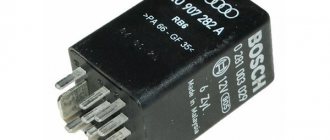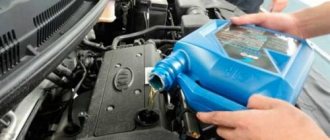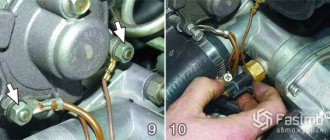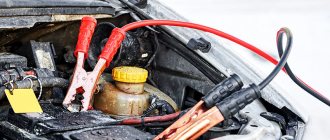An engine pre-heater is equipment designed to heat the power unit and guarantee its starting in severe frost. After activating the system, the engine warms up and starts easier.
Additionally, preheating is used to create comfortable conditions in the cabin when the engine is not running.
Below we will consider what types of such devices there are, we will present the best pre-start heaters for 220 / 12 V with and without a pump, according to user reviews.
We will separately highlight the recommendations of specialists on the selection of equipment.
Types of pre-heaters
Structurally and according to the principle of operation, heaters are of three types:
- Electrical. They connect to regular sockets and operate on 220 V.
- Autonomous liquid. They require power from the on-board network for 12 and 24 V. They are installed in the engine compartment and operate on diesel fuel, gas or gasoline. The operating principle is based on the ignition of the air-fuel mixture in the combustion chamber of the device, followed by the movement of the heated coolant (coolant) in a certain circle.
- Thermal accumulators. They work on the principle of accumulating heated coolant in a thermos of the system while maintaining the set temperature for 48 hours. During the startup process, the heated liquid flows through the small circuit of the system, heating the main antifreeze by 15-20 degrees.
Thermal batteries are not considered in our article due to their rare use in cars.
Main advantages and disadvantages
- use in any climate zone;
- low cost;
- not a complex design;
- simple diagram;
- easy installation;
- saving fuel consumption;
- reliability;
- high degree of security;
- durability;
- the battery does not lose charge;
- recharging the battery;
- ease of maintenance;
- after warming up, the starter load decreases;
- wear of parts is reduced;
- additional features will allow you to preheat the interior and eliminate icing of the windows.
The only disadvantage of such boilers is their dependence on the electrical network.
Which engine heater is better to install?
When choosing a suitable heater, you need to focus on the place where the car is used.
When using a vehicle in a city and having access to a household network, you can use inexpensive models with a 220 V connection.
If you frequently travel outside the city, for example, when using transport far from urban conditions, you should give preference to autonomous models.
This is relevant for large trucks and buses that travel long distances, as well as for remote northern regions of Russia.
In this case, you need to correctly navigate the manufacturers and installation details.
Some aspects and nuances
When using preheating, it is recommended to take into account the following points:
- a switch with a timer will ensure engine heating in the mode that the vehicle owner needs;
- the engine is started with the clutch depressed;
- I do not lay the 220V wire through high-voltage supports on the road;
- If the boiler power is higher than 1.0 kW, you should not leave it on overnight.
Compliance with these rules will protect you from fines from the fire inspection and unpleasant situations.
The best manufacturers on the Russian market
The high demand for engine heaters inevitably led to the expansion of the market and the emergence of many manufacturers.
Today there are at least a dozen large companies offering their products in Russia.
The main ones include:
- CJSC Leader is a manufacturing plant with Russian registration. Has been operating since 1993. The main direction is the production of electric preheaters.
- Binar is a commercial enterprise established in 1989 in Sarov. It produces products for cars and is the winner of many ratings. Represents a large range of pre-start devices for diesel engines, with or without a pump.
- Airline is another well-known brand that produces heating devices with a large selection of power ratings. It is characterized by uniform heating of the system in cold weather and helps to increase engine reliability.
- Longfei is a Chinese manufacturer producing heaters that are in great demand in Russia. Sells heating products and car accessories to many countries. Uses high quality materials and uses modern technologies during work.
- Orion is a domestic manufacturer focused on the production of engine heaters operating on an electrical principle. It produces a wide range of models with different powers, characterized by instant start-up. The plant's products are sold not only in Russia, but also in other countries.
- Nomakon is a plant that produces devices for heating the fuel system, capable of operating for a short time or on an ongoing basis. They are universal, suitable for cars of different brands/models. The brand's products are supplied to many European countries.
- Severs is a Russian manufacturer that produces reliable and high-quality products. The brand's products are distinguished by guaranteed and easy starting, high quality components, built-in protection and ease of installation.
- Teplostar is a company engaged in the production of heating devices for cars of various capacities. The devices are made from high quality materials, are sold in many countries, and guarantee uninterrupted operation of the machine even in cold weather.
- Advers is a Samara manufacturer that produces high-quality preheaters with or without a pump, for diesel or gasoline. Manufactured devices have different power levels, are reliable and easy to start.
- Webasto is a manufacturer originally from Germany, which activates the fast operation of the machine. The manufacturer produces devices for many models, and the effectiveness is confirmed by practical use even at sub-zero temperatures. The brand's products are sold in many countries around the world.
Some heater models from the manufacturers listed above are included in our rating, which simplifies the choice of device.
Recommendations for choosing a boiler
To figure out which 220V boiler to choose from the entire variety of models on the market, it is important to consider the following factors:
- boiler from 220V with a specialized coating;
- a boiler without boiling points to prevent deposits from forming;
- a cheap boiler does not fit well with the aggressive antifreeze environment.
The boiler is manufactured with the following power gradations:
- 1.5 kW – for a 16kl engine;
- 1.0 kW – for an 8kL engine;
- 0.5 kW – for use when parked for regular engine heating.
A good example
The period for heating is selected individually, experimenting and choosing. Decisive factors:
- type of engine;
- boiler rated power;
- ambient air temperature.
Now boilers are made of square-shaped plastic.
On average, the boiler heats up for 40-60 minutes. In this case, it is important that the engine is hot, but the liquid does not boil.
You need to buy a boiler only from trusted commercial manufacturers of this type of product.
You can purchase the boiler on the manufacturer’s websites, in specialized retail outlets or at the car market.
Due to the wide range and many models, the device is selected for cars, trucks, and SUVs.
Installation features
Installation features differ for different types of engine heaters; much depends on the manufacturer and design features of the devices, the type of fuel used, and the car model.
As a rule, the kit already includes everything that is necessary for installation, and instructions are also included.
IMPORTANT: the material below is not an instruction; it will only allow you to become familiar with the general principles of installing heaters in order to guide the reader for further work.
Electrical 220 V
Before installation, you need to inspect the kit, study the instructions and find a nearby outlet.
The last factor forces you to do the work closer to the garage or other place where it is possible to connect to 220 V.
Below we will look at installing a self-made engine heater.
The general algorithm is:
- Assemble the kit. Most often it includes heating elements, fittings and fittings.
- Buy a one-inch (standard) pipe tee. It can be found at any plumbing store. The heating element, which is needed to heat the unit, is also sold here. It is better to take a heater with a built-in 1500 W thermostat.
- Install the heating element at the end of the tee, and connect a 10-centimeter pipe at the other end. It is needed to warm up the system faster.
- Place plugs on the unused outlet and the end of the pipe for subsequent connection of the pipes.
- Connect the resulting part to the coolant circulation system in the car. To do this, find the exit point to the stove and install a homemade unit into the gap.
- Connect a wire of the required cross-section to the heating element contacts.
- Install a pump so that when the power unit is turned off, the working fluid continues to circulate.
The pump is installed in front of the heating element using an open relay or using a simple socket. Use a pump from Gazelle, which has better functionality and won’t put a big dent in your pocket.
If you do not have the skills to perform such work, you can buy a ready-made kit.
In this case, there should be detailed installation instructions inside. Please note that in the absence of experience and independent work, there is a high risk of harming the car engine.
Installation of autonomous liquid
Let us separately consider the installation features for autonomous engine heaters using the Webasto Thermo Top as an example.
INSTALLATION OPTIONS:
The insertion of the pre-heater into the cooling system of the car is carried out using one of the methods discussed below:
- Universal. It involves connecting the heater into the gap between the engine and the interior heating radiator. The advantage of this method is that it quickly heats the air inside the machine. The antifreeze entering the engine cooling jacket has time to cool down. Consequently, it takes more time to heat up the power unit.
- Installation in a secondary circuit. It involves inserting the heater into the gap between the engine and the heater radiator with parallel placement of the check valve. This feature allows you to place the heater closer to the radiator to reduce heat loss.
- Installation in a large liquid circuit. This design option contributes to better heating of the interior with minimal losses in a large circuit.
- Installation oriented towards the primary heating of the engine. More suitable for quickly heating the unit.
Types of electric heaters
| Models | Manufacturer country | Price in rubles |
| Block | ||
| OWL with pump | Germany | 6500-7500 |
| DEFA | Norway | 4000-6000 |
| Calix | Sweden | 3000-4500 |
| "Start-Mini" | Russia | 1000-2900 |
| "Street Boy" | Russia | 1500-3500 |
| Branch pipes | ||
| "Lestar" | Russia | 1700-3300 |
| "Alliance" | Russia | 1000-2500 |
| "Start M1/M2" | Russia | 1400-2800 |
| "Sibir M" | Russia | 1000-2000 |
| Remote | ||
| Hotstart | USA | 9000-60000 |
| "Severs-M" | Russia | 2000-2800 |
| "Start-M" | Russia | 1900-3200 |
| "Alliance" | Russia | 1600-3000 |
| "Xin Ji" | China | 1500-2700 |
| External | ||
| Keenovo | China | 3600-5000 |
| Hotstart | USA | 9500-10000 |
Block
This type of heating systems for cars is designed to be built into the cylinder block (BC) of the power unit. As a result of the fact that the BC heats up, the power unit warms up evenly and centrally.
The power of the heating element itself is not very high - 400-750 V.
In terms of design, such devices are quite simple, since they are equipped only with a heating component and a connector that must be connected to the motor. There are no fastenings or additional elements in the heater.
Table: block heater models
| Characteristic | OWL with pump | DEFA | Calix | "Start-Mini" | "Street Boy" |
| Operating power | 1100 watt | 300-600 watts | 550 watt | 1-2 kilowatts | 500-630 watts |
| Heating capacity | 14 kilowatts | 1.5-5 kilowatts | 750 watt | 4 kilowatts | 1.8-5 kilowatts |
| Weight | 0.38 kg | 0.85-1.05 kg depending on model | 0.35-1.20 kg | 0.785 kg | 0.27 kg |
| Presence of anti-corrosion housing | Available | Available | Depends on model | Depends on model | No |
| Startup mode | Auto | Auto | Depends on model | Depends on model | Manual |
| Type and frequency of current | Variable, 50 hertz | Variable, 50 hertz | Variable, 50 hertz | Variable, 50 hertz | Variable, 50 hertz |
| Auto shutdown | Available | Available | Depends on model | Thermal switch | No |
| Warm-up time | About 30 minutes | from 20 minutes to 3 hours | 1.5-8 hours | 30-60 minutes | At least 1 hour |
Advantages and disadvantages
Pros according to reviews +++
The possibility of long-term operation associated with low power, due to which the refrigerant does not deteriorate.
Operational safety. Modern heaters are supplied with thermal insulation material that will prevent the insulation on nearby wires from melting.
Easy to install
Cons according to reviews -
Long warm-up time.
At an ambient temperature of 0 degrees, the system will be able to heat the consumable in only one hour of operation. If the air temperature drops to -10 degrees, this figure will increase to two hours. Accordingly, if you choose a less powerful and budget version of the heating system, heating the refrigerant will take even longer. Mechanical heater timers may malfunction in cold weather
Low heater power
Video: review of the Chinese preheater
The channel “Parcels from China for CergeyNchina” published a video in which the characteristics and capabilities of the motor heating system ordered in China are presented in detail.
Branch pipes
Such devices are designed for installation in the cut of thick hoses. Universal models of heating systems are equipped with durable housings, which eliminates the possibility of damage to the unit as a result of physical impact.
Table: models of pipe heaters
| Characteristic | "Lestar" | "Alliance" | "Start M1/M2" | "Sibir M" |
| Operating power | 5-8 kilowatts | 2 kilowatts | 1-2 kilowatts | 1-3 kilowatts |
| Heating capacity | 15 kilowatts | Not specified | 4 kilowatts | 15 kilowatts |
| Weight | Not specified | 0.9 kg | 0.785 kg | 0.9 kg |
| Presence of anti-corrosion housing | Available | IP34 housing | Depends on model | Anodized aluminum housing |
| Startup mode | Manual | Manual | Depends on model | Manual |
| Type and frequency of current | Variable, 50 hertz | Variable, 50 hertz | Variable, 50 hertz | Variable, 50 hertz |
| Auto shutdown | Absent | Absent | Thermal switch | Thermal switch |
| Warm-up time | At least 1 hour | At least 1 hour | 30-60 minutes | 460-60 minutes |
Advantages and disadvantages
Pros according to reviews +++
Easy installation and connection
High-quality heat transfer, allowing you to effectively warm up the power unit
Ease of use
Relatively cheap and large range of devices from different manufacturers
Cons according to reviews -
Heaters are always designed for standard hose diameters, so during installation you will have to additionally install an adapter.
Video: review of the Start-M heating system
A video has been published on the Sergei Pukhov channel, which presents in detail the characteristics, features and overview of the configuration of the Start-M heating devices.
Remote
The design of remote heaters is more complex and additionally includes:
- pipes;
- adapters;
- thermostats;
- fastenings and clamps, etc.
The heating element is more powerful - the average consumption for passenger cars is from 1-2 kilowatts; for trucks, 3 kW heaters are usually used.
Table: models of remote heaters
| Characteristic | Hotstart | Severs-M | Start-M | Alliance | Xin Ji (Longfei) |
| Operating power | 5-25 kilowatts | 1-3 kilowatts | 1-2 kilowatts | 800 watt | 2 kilowatts |
| Heating capacity | 4 kilowatts | Not specified | 4 kilowatts | Not specified | 5 kilowatt |
| Weight | 0.77 kg | Not specified | 0.78 kg | 0.46 kg | 0.98 kg |
| Presence of anti-corrosion housing | Yes | Anodized aluminum housing | Yes | IP34 housing | Yes |
| Startup mode | Manual/automatic | Manual | Depends on model | Manual | Depends on model |
| Type and frequency of current | Variable, 50 hertz | Variable, 50 hertz | Variable, 50 hertz | Variable, 50 hertz | Variable, 50 hertz |
| Auto shutdown | At 50 degrees | Absent | Thermostat | Thermostat | temperature sensor |
| Warm-up time | From 30 minutes | Up to 1 hour | Up to 1 hour | From 30 minutes | 30-50 minutes |
Advantages and disadvantages
Pros according to reviews +++
Inexpensive installation
Large selection of models from different manufacturers at different prices
Ease of use
Cons according to reviews -
It is necessary to ensure free access to the plug.
To eliminate this drawback, you can purchase a remote bumper heater. Domestic and Chinese-made systems are less reliable and fail faster. Due to leaks, they can leak refrigerant, so additional sealant must be used during installation.
Poor quality and fragility of additional devices (the problem is more typical for Chinese systems). Therefore, before installation, it is recommended to purchase imported pipes, duralumin adapters instead of plastic ones, and the holders should be replaced with stronger and wider clamps.
Difficult to install yourself
Video: review of the Chinese Longfei engine heater
The channel “Parcels from China for CergeyNchina” presents a video about the operation, as well as the installation and characteristics of the Longfei engine pre-heaters.
External
External heating systems are heating plates that are placed on the power unit housing, crankcase, cylinders, etc. Heating plates operate on the basis of thermal electric heaters, and most of them can be connected not only to a 220-volt network, but also to a 12-volt car battery IN.
The power level of such devices varies from manufacturer to manufacturer and averages from 100 to 1500 W. The temperature that the plate can develop is from 90 to 180 degrees.
Good to know
The electrical components of the plates are not allowed to be used for heating batteries, as this can lead to boiling of the electrolyte and destruction of the internal elements of the battery.
Table: models of external heaters
| Characteristic | Keenovo | Hotstart |
| Operating power | 0.8 kilowatt | 5-25 kilowatts |
| Heating capacity | Not specified | 4 kilowatts |
| Weight | Not specified | 0.77 kg |
| Presence of anti-corrosion housing | No | Yes |
| Startup mode | Manual | Auto |
| Type and frequency of current | Variable, 50 hertz | Variable, 50 hertz |
| Auto shutdown | At 90 degrees | At 50 degrees |
| Warm-up time | About 15 minutes | 20-40 minutes |
Advantages and disadvantages
Pros according to reviews +++
Safety of use - the devices are reliably protected from exposure and ingress of moisture and small particles, the degree of protection complies with the IP65 standard
. Easy installation. To complete the task, you only need to glue the plate to the work surface.
Increased resistance to wear and abrasion
Long service life and reliability
Cons according to reviews -
High cost of the product
Rapid wear of the battery if the connection is made to it and not to a 220-volt network. To eliminate this drawback, you need to install a more powerful battery.
Video: Keenovo heating plate test
A video has been published on the channel “Your Lunapark”, which shows the process of testing the operation of silicone heating plates for starting an internal combustion engine and its results.
What to consider when installing an autonomous heater
To avoid errors during installation, it is necessary to take into account a number of important points, which we will dwell on in more detail.
Fuel supply
Experts do not recommend using a fuel intake near the engine. This is especially true for gasoline engines.
Excessive temperature rise leads to evaporation of fuel and the appearance of gas bubbles.
In addition, to avoid mistakes, it is important to consider the following recommendations:
- Place a fine filter in front of the engine heater fuel pump.
- Place the pump in a cool place. It is important that the temperature during operation is no more than +20 degrees Celsius.
- Connect and secure all connection points of the fuel lines with clamps, and secure the tubes themselves with ties.
- Make sure that the distance between the fuel tank and the pump is up to 120 cm. The distance between the heater and the fuel pump is up to 5.8 m.
- Pay attention to the markings on the pump. It shows in which direction the coolant is directed.
- Before installation, study which parameter of the internal diameter of the fuel line is relevant for a specific engine heater model.
Requirements for air intake, heater, exhaust system
During the installation process, it is important to take into account a number of points regarding the following components: air intake, heater and exhaust system.
Basic points:
- Place the air intake in a cool place, protected from dirt.
- Place the muffler on an arch or other place where there is no risk of overheating of plastic elements.
- Do not place the heater exhaust pipe in the direction of travel. The best option is to direct the exhaust to the transmission pan, which also needs to be warmed up in winter.
- If it is not possible to use a standard mount, upgrade it or make a new bracket. In this case, it is forbidden to mount the housing on self-tapping screws. It is important that it is strong and not affected by extraneous vibrations.
- Mount the heater housing and coolant pump at the lowest possible point. This is necessary to improve deaeration. Taking into account the fact that the model in question does not have a self-suction function, it cannot be placed above the liquid level in the tank.
- Make sure that during operation, no fuel or oil drips onto the heater, or dirt gets in.
- Take the antifreeze pipes yourself, and measure the length before doing so. To go to the store, you need to know the outer diameter of the heating fittings, as well as the size of the holes in the car’s cooling and interior heating system.
- When attaching hoses with clamps, make sure that they are securely fastened at the connection points. Please ensure that they are protected from abrasion.











